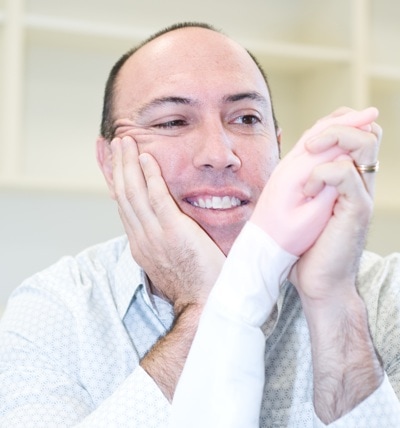It has been about a month since I wrote a post reflecting on this pain I have in my shoulder. I must say I was overwhelmed by the many offers of diagnostic and treatment advice – it left me both chuffed and a little apprehensive about revisiting it.
To start, let me say that my shoulder is less painful than it was. I have been a very good patient, I might say – in the gym every second day, keeping as fit as I can (I have in fact lost 3 kg!), taking my NSAIDS strictly on dose. However, that is all fairly understandable – one might observe that I am that kind of fellow.
Other things have been more of a challenge. For example, I have noticed that some of my movements tend to be accompanied by little groans or expirations. I screw up my face a little when I do something that hurts and – get this – when I do something I expect will hurt. This is a very intriguing and enlightening journey for me – I am almost excited at what I am learning about having persistent bothersome pain, and also what I am learning about me (although, truth be known, some of it is just a little disappointing).
On each of these occasions, when I find myself behaving in a manner I see in my patients, or having cognitive intrusions about which I read and write on a weekly basis, I am grateful for the opportunity to ask MYSELF the sort of questions we ask about people in pain: ‘What was the point of that groan?’ or ‘Why did I screw up my face then?’ or ‘But there is so much evidence AGAINST that scenario’. Do we groan just to communicate?
Bill Fordyce, the guy who pioneered the formal use of operant conditioning for chronic pain, would jump on these behaviours and suggest that it is they that is causing a big chunk of the problem. Actually, I guess he would not do anything with them but would look to occasions of not groaning and reinforce them, but you get what I mean.
I reckon Professor Michael Nicholas (congratulations are in order – this is one Professorship that has been deserved for eons), one of the real heavyweights of cognitive-behavioural approaches to pain management and a key player in the development of INPUT at St Tommy’s in London, and ADAPT at Royal North Shore Hospital in Sydney, would suggest it is ALL about communicating.
The question I now have, as a kind of insider, at least to some extent, is ‘Well what about when I groan when I KNOW noone is around?’ With whom am I communicating then? I don’t think it is a habit that has been established by repeated activation whilst around people. Yet. Not specifically this one at least – perhaps it is a generalised response from occasions, of which there are many, on which my grimaces have been met by a loving parent or partner and that made me feel safer. That is reasonable I guess, but it doesn’t FEEL like that. Furthermore, the notion that it is JUST a habit does feel a little illegitimate – this is a good reminder of what patients feel when we fail to get into their skin even if we are making very sensible suggestions about their situation.
The last bit I want to reflect on is this cognitive intrusion thing. I have found it most interesting indeed and not a small nuisance. I can almost hear the conversation going on inside me. On the one hand is a person in pain, the cause of which is not clear, with an unclear prognosis but a gaggle of undifferentiatable possibilities of various impact, a person with a better than average understanding of biology and a better than average set of resources with which to engage with the problem, a job that is not under threat, excellent social and family support, a payable mortgage etc etc (the point here is to reflect on how lucky this patient is in those ways and how different that is to some of our patients).
On the other hand is a person who is a supposed international leader in clinical pain science, a person who has written papers and books on the subject, who has had his chronic pain and recovered, who has ‘form’ (this actually reminds me of a conversation with The Beautiful Anna, where we were reflecting on how helpful it is for parents to have more than one kid so that they realise that however good or bad their first kid is, it is not because of the way they were parented!)
These are the sort of conversations that go on inside me: ‘Bilateral pains huh? BOTH shoulders are stuffed – how will I get BOTH reconstructed?’….‘You didn’t injure it just before the pain came on so the damage shown on the MRI you have has been there for yonks’….‘The right shoulder is doing exactly what the left did – you are staring down the barrel of months of bad sleep – get a steroid injection – it will give you a week’s relief’…‘Bilateral pain? Obvious immune-related mechanisms at spinal or thalamic level that can explain that one – no worries just part of the gloriously sophisticated protective mechanisms’….‘Could be lupus’…‘Lupus! You are kidding! You are not fatigued, your neck and back aren’t sore, no-one in your extended family has had it’….’OK so now your back hurts and your neck is getting stiff….your aunty died young – maybe she would have got it’…etc etc etc.
I don’t want to give the impression that I really am ruminating on this stuff, but I do want to remind all of us who are in the business or vocation of treating people in pain, that these cognitive intrusions – what David Butler might call cognitive ignition nodes, are stubborn little suckers. The thing is, I KNOW that all these things can upregulate the pain and nociceptive system and I have a very large amount of data available to reduce their impact, but they remain stubborn little suckers. What I want most now is more accurate information – I don’t have the skills or knowledge to get the clarity I want. We must all remember this when someone in pain is grimacing and groaning and telling us they think their disc is squashing their spinal cord.
About Lorimer Moseley
 Lorimer is NHMRC Senior Research Fellow with twenty years clinical experience working with people in pain. After spending some time as a Nuffield Medical Research Fellow at Oxford University he returned to Australia in 2009 to take up an NHMRC Senior Research Fellowship at Neuroscience Research Australia (NeuRA). In 2011, he was appointed Professor of Clinical Neurosciences & the Inaugural Chair in Physiotherapy at the University of South Australia, Adelaide. He runs the Body in Mind research groups. He is the only Clinical Scientist to have knocked over a water tank tower in Outback Australia.
Lorimer is NHMRC Senior Research Fellow with twenty years clinical experience working with people in pain. After spending some time as a Nuffield Medical Research Fellow at Oxford University he returned to Australia in 2009 to take up an NHMRC Senior Research Fellowship at Neuroscience Research Australia (NeuRA). In 2011, he was appointed Professor of Clinical Neurosciences & the Inaugural Chair in Physiotherapy at the University of South Australia, Adelaide. He runs the Body in Mind research groups. He is the only Clinical Scientist to have knocked over a water tank tower in Outback Australia.
Link to Lorimer’s published research here. Downloadable PDFs here.
Thanks to all of you who commented on part one of this post. We got a ton of correspondence – too many to publish. For those of you who write in with clinical advice or personal questions, rest assured we will pass those on but won’t publish them here.
The point of this post is to foster conversation not on Lorimer but on the things he describes.



